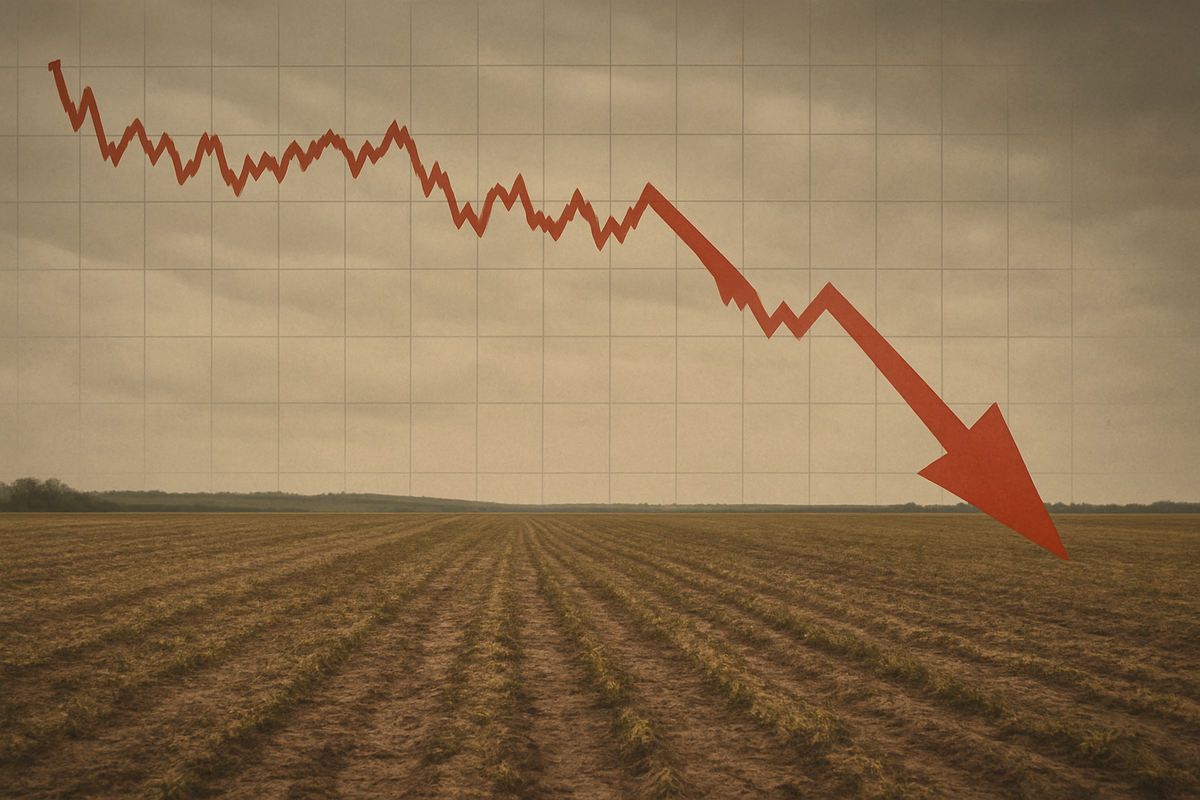
Federal Agricultural Mortgage Corporation (NYSE: AGM), widely known as Farmer Mac, saw its stock plunge to a new 52-week low of $159.34 USD on October 6, 2025. This significant dip marks a 12.46% decline over the past year, signaling a challenging period for the government-sponsored enterprise (GSE) and the broader agricultural finance sector it serves. The downturn immediately places the stock in oversold territory according to its Relative Strength Index (RSI), prompting market watchers to assess whether a rebound is on the horizon or if deeper issues are at play.
Farmer Mac's core mission is to provide a secondary market for agricultural real estate and rural housing mortgage loans, thereby enhancing liquidity and credit availability for farmers, ranchers, and rural communities. Despite the recent stock performance, the company boasts impressive underlying fundamentals, including a P/E ratio of 7.27x and a robust 3.68% dividend yield, supported by a 22-year track record of consistent dividend payments and a 7.14% growth in the last twelve months. This divergence between stock price and fundamental strength presents a complex picture for investors trying to navigate the current market landscape.
Detailed Coverage: Unpacking Farmer Mac's Recent Downturn
The precipitous drop in Federal Agricultural Mortgage Corporation (NYSE: AGM) stock to a 52-week low on October 6, 2025, is a culmination of evolving dynamics within the agricultural finance sector and broader market sentiment. While the exact catalysts for the single-day low are often multifactorial, the past year has seen a steady erosion of investor confidence, culminating in this recent benchmark. The 12.46% year-over-year decline reflects growing concerns over the health of the agricultural economy, which directly impacts Farmer Mac's operational environment.
Farmer Mac's role as a secondary market facilitator means its fortunes are intricately tied to the primary agricultural lending market. Factors such as fluctuating commodity prices, trade policies, interest rate movements, and environmental challenges like droughts or floods can directly influence the demand for agricultural loans and the credit quality of borrowers. A slowdown in agricultural growth or an increase in loan defaults could put pressure on Farmer Mac's guarantee business, even with its robust risk management frameworks. The current market reaction suggests that investors are pricing in increased risk or reduced growth prospects for the sector.
Despite the stock's recent performance, initial market reactions have also highlighted Farmer Mac's underlying financial resilience. The stock's Relative Strength Index (RSI) indicating oversold conditions suggests that the selling pressure might be overdone, potentially attracting value investors. Furthermore, the company's strong fundamentals, including a low P/E ratio of 7.27x and an attractive dividend yield of 3.68%, coupled with a long history of dividend payments, underscore a perception of fundamental stability that contrasts sharply with the stock's price action. Analysts currently maintain a "Hold" rating with a median price target of $217.80, implying a significant upside from the current low, and some analyses from sources like Zacks even assign Farmer Mac an "A" Value Score, suggesting it may be undervalued. This divergence points to a battle between market psychology driven by sector-wide anxieties and the intrinsic value seen by fundamental analysts.
Companies on the Brink: Winners and Losers in Agricultural Finance
The significant dip in Federal Agricultural Mortgage Corporation (NYSE: AGM) stock sends ripples across the agricultural finance ecosystem, potentially creating both winners and losers among various stakeholders. As a government-sponsored enterprise, Farmer Mac plays a unique role, meaning its direct competitors in the secondary market space are limited. However, its performance and the underlying reasons for its stock decline can impact primary lenders and other financial institutions involved in rural credit.
Traditional agricultural lenders, such as regional banks and Farm Credit System institutions, which originate loans that Farmer Mac often purchases or securitizes, could face indirect consequences. If the broader market perceives increased risk in agricultural loans, these primary lenders might experience tighter credit conditions or increased scrutiny from regulators and investors. Conversely, if Farmer Mac's reduced market valuation leads to strategic shifts or a more cautious approach to loan purchasing, these primary lenders might need to adjust their own liquidity management and loan portfolio strategies. However, if Farmer Mac's current low is indeed an overreaction, and its fundamentals hold strong, it could present an opportunity for these lenders to continue leveraging Farmer Mac's secondary market functions for liquidity.
On the other hand, entities involved in alternative agricultural financing or those with less exposure to traditional mortgage-backed agricultural assets might find themselves in a relatively stronger position. Private equity firms or specialized investment funds looking for distressed assets or undervalued opportunities within the agricultural sector could view Farmer Mac's low valuation as an entry point. Moreover, technology-driven agricultural finance platforms that offer different lending models or risk assessment tools might gain market share if traditional methods are perceived as faltering. Ultimately, the winners will likely be those institutions with diversified portfolios, robust risk management, and the agility to adapt to shifting market sentiments and economic conditions within the agricultural landscape.
Wider Significance: A Barometer for the Agricultural Economy
The 52-week low for Federal Agricultural Mortgage Corporation (NYSE: AGM) extends beyond a mere stock price movement; it serves as a critical barometer for the health and outlook of the broader U.S. agricultural economy. As a government-sponsored enterprise deeply embedded in facilitating agricultural credit, Farmer Mac's performance often reflects the underlying conditions faced by farmers, ranchers, and rural communities. This event fits into a larger narrative of evolving challenges within the agricultural sector, including volatile commodity prices, rising input costs, geopolitical trade tensions, and the increasing frequency of extreme weather events impacting crop yields and livestock.
The potential ripple effects of Farmer Mac's stock performance could be significant. A prolonged period of investor apprehension or a perceived weakening of Farmer Mac's ability to provide liquidity could impact the availability and cost of credit for agricultural producers. This, in turn, could slow down investment in farm improvements, expansion, or even force some operations to scale back. Competitors, while not directly replicating Farmer Mac's GSE model, such as large commercial banks with agricultural portfolios or the cooperative Farm Credit System, will be closely watching for any changes in market dynamics or regulatory responses. A more cautious lending environment could lead to increased demand for their services, or conversely, expose them to similar underlying sector risks.
From a regulatory standpoint, Farmer Mac's status as a GSE means its financial stability is of particular interest to government bodies. Any sustained weakness could prompt increased oversight or even discussions about potential policy interventions to ensure the continued flow of credit to a vital sector of the economy. Historically, periods of agricultural stress have often led to government support or new programs designed to stabilize rural finance. Comparing this event to past agricultural downturns, such as the farm crisis of the 1980s, while not directly analogous due to Farmer Mac's established role today, highlights the sensitivity of agricultural finance to macroeconomic shocks and sector-specific challenges. The current situation underscores the need for robust risk management and adaptive strategies across the entire agricultural value chain.
What Comes Next: Navigating the Future of Agricultural Finance
The immediate aftermath of Federal Agricultural Mortgage Corporation (NYSE: AGM) hitting a 52-week low will undoubtedly involve intense scrutiny from investors, analysts, and agricultural stakeholders. In the short term, the market will be watching for any official statements or strategic responses from Farmer Mac's management, particularly regarding their outlook on credit quality, loan demand, and any potential adjustments to their operational strategy. Given the stock's oversold status and strong fundamentals, a technical rebound could occur if positive news emerges or if broader market sentiment towards agricultural assets improves. However, sustained recovery will hinge on addressing the underlying concerns driving the stock's decline.
In the long term, Farmer Mac may need to consider strategic pivots to mitigate future risks and enhance investor confidence. This could involve diversifying its portfolio further, exploring new areas of rural infrastructure financing, or refining its risk assessment models to better account for evolving agricultural challenges like climate change impacts. The company's ability to continue attracting global capital to the agricultural sector will be crucial. Potential market opportunities may emerge for Farmer Mac if it can leverage its GSE status to innovate in areas like sustainable agriculture financing or support for emerging agricultural technologies, which could differentiate its offerings and attract new investor segments.
Potential scenarios range from a gradual recovery, where the stock slowly regains ground as the agricultural economy stabilizes and Farmer Mac's fundamental strength reasserts itself, to a more challenging period if agricultural headwinds persist or intensify. A worst-case scenario might involve a significant downturn in agricultural profitability leading to widespread loan defaults, though Farmer Mac's robust guarantee mechanisms and government backing are designed to mitigate such extreme outcomes. Conversely, a best-case scenario could see the current low as a temporary blip, with the stock rebounding strongly as investors recognize its undervaluation and the long-term necessity of its role in rural America. The coming months will be critical in determining which path Farmer Mac and the broader agricultural finance market will take.
Wrap-up: Assessing Farmer Mac's Resilience and Future Path
The recent 52-week low for Federal Agricultural Mortgage Corporation (NYSE: AGM) serves as a potent reminder of the inherent volatility and cyclical nature of financial markets, even for government-sponsored entities with critical mandates. The key takeaway from this event is the striking divergence between Farmer Mac's strong underlying fundamentals—evidenced by its attractive valuation metrics, consistent dividend history, and essential role in agricultural finance—and the current negative investor sentiment reflected in its stock price. This situation highlights the market's current anxieties regarding the broader agricultural sector, rather than necessarily a fundamental weakening of Farmer Mac itself.
Moving forward, the market will closely assess Farmer Mac's resilience and its ability to navigate the complex landscape of agricultural finance. While the immediate future might see continued price fluctuations, the long-term outlook will depend on how effectively Farmer Mac can communicate its strategic vision, manage risks associated with the agricultural economy, and continue to fulfill its mission of providing liquidity to rural lenders. Investors should watch for any shifts in agricultural commodity prices, interest rate policies, and government support for the sector, as these external factors will heavily influence Farmer Mac's operating environment.
Ultimately, the lasting impact of this 52-week low will be determined by whether it acts as a temporary market correction, an opportunity for value investors, or a precursor to more significant challenges for the agricultural finance industry. Farmer Mac's foundational role in supporting rural America remains undisputed, and its ability to adapt and thrive amidst evolving economic conditions will be a critical storyline for investors and stakeholders in the months and years to come.
This content is intended for informational purposes only and is not financial advice.





